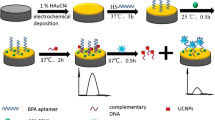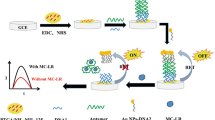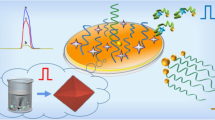Abstract
A highly selective and sensitive “on–off–on” electrochemiluminescence (ECL) aptasensor based on a self-enhanced luminophore was developed for the detection of ochratoxin A (OTA). Specifically, polyethyleneimine functionalized multi-walled carbon nanotubes decorated with gold nanoparticles (AuNPs-PEI-MWCNTs) were used as the electrode matrix to accelerate electron transfer and provide a favorable microenvironment for self-enhanced luminophore loading and ECL signal enhancement. In addition, black phosphorus quantum dots (BPQDs) were used as co-reactants of the ECL reagent tris (2,2′-bipyridyl) ruthenium(II) (Ru(bpy)32+) in ECL experiments, and the reaction mechanism was investigated. The self-enhanced luminophore Ru@SiO2-BPQDs was obtained by encapsulating Ru(bpy)32+ in silica (SiO2) nanoparticles and then combining it with BPQDs through electrostatic interaction. In conventional ECL systems, the emitter and its co-reactants reacted via the inter-nanoparticle pathway, leading to long distance electron transfer. However, the electron transfer distance in the self-enhanced luminophore was significantly shortened due to the intra-nanoparticle electron transfer pathway because BPQDs and oxidized Ru(bpy)32+ were bound within one nanoparticle, thereby improving ECL efficiency to achieve the first “switch-on” state. Then, the luminophore was quenched using ferrocenes (Fc) modified on an aptamer to achieve the “switch-off” state. Finally, OTA was specifically identified by the adapter, causing Fc to be released from the sensor interface, restoring the ECL intensity to achieve the second “switch-on” state. Under optimal conditions, the aptasensor exhibited good sensitivity, stability, and reproducibility, with a linear detection range from 0.1 to 320 ng/mL and a detection limit of 0.03 ng/mL. The novel ECL aptasensor provided a common analytical tool for the detection of mycotoxins and other small molecules.








Similar content being viewed by others
References
Zhou J, Yang Q, Liang C, Chen Y, Zhang X, Liu Z, et al. Detection of ochratoxin A by quantum dots–based fluorescent immunochromatographic assay. Anal Bioanal Chem. 2021;413:183–92.
Zhai S, Zhu Y, Feng P, Li M, Wang W, Yang L, et al. Ochratoxin A: its impact on poultry gut health and microbiota, an overview. Poult Sci. 2021;100(5):101037.
Vlachou M, Pexara A, Solomakos N, Govaris A. Ochratoxin A in slaughtered pigs and pork products. Toxins. 2022;14(2):67.
Chen J, Chen Y, Zhu Q, Wan J. Ochratoxin A contamination and related high-yield toxin strains in Guizhou dried red chilies. Food Control. 2023;145:109438.
Zhang H, Wang Y, Lin Y, Chu W, Luo Z, Zhao M, et al. A catalytic hairpin assembly–based Förster resonance energy transfer sensor for ratiometric detection of ochratoxin A in food samples. Anal Bioanal Chem. 2023;415(5):867–74.
Chen R, Sun Y, Huo B, Yuan S, Sun X, Zhang M, et al. Highly sensitive detection of ochratoxin A based on bio-barcode immunoassay and catalytic hairpin assembly signal amplification. Talanta. 2020;208:120405.
Alhamoud Y, Yang D, Kenston SSF, Liu G, Liu L, Zhou H, et al. Advances in biosensors for the detection of ochratoxin A: bio-receptors, nanomaterials, and their applications. Biosens Bioelectron. 2019;141:111418.
Susca A, Anelli P, Haidukowski M, Probyn CE, Epifani F, Logrieco AF, et al. A PCR method to identify ochratoxin A-producing Aspergillus westerdijkiae strains on dried and aged foods. Int J Food Microbiol. 2021;344:109113.
Okuma TA, Huynh TP, Hellberg RS. Use of enzyme-linked immunosorbent assay to screen for aflatoxins, ochratoxin A, and deoxynivalenol in dry pet foods. Mycotoxin Res. 2018;34:69–75.
Song L, Li J, Li H, Chang Y, Dai S, Xu R, et al. Highly sensitive SERS detection for aflatoxin B1 and ochratoxin A based on aptamer-functionalized photonic crystal microsphere array. Sens Actuators, B Chem. 2022;364:131778.
He K, Sun L, Wang L, Li W, Hu G, Ji X, et al. Engineering DNA G-quadruplex assembly for label-free detection of ochratoxin A in colorimetric and fluorescent dual modes. J Hazard Mater. 2022;423:126962.
Luci G. A rapid HPLC-FLD method for ochratoxin A detection in pig muscle, kidney, liver by using enzymatic digestion with MISPE extraction. MethodsX. 2020;7:100873.
Jia M, Jia B, Liao X, Shi L, Zhang Z, Liu M, et al. A CdSe@CdS quantum dots based electrochemiluminescence aptasensor for sensitive detection of ochratoxin A. Chemosphere. 2022;287:131994.
Chen H, Zhang H, Yuan R, Chen S. Novel double-potential electrochemiluminescence ratiometric strategy in enzyme-based inhibition biosensing for sensitive detection of organophosphorus pesticides. Anal Chem. 2017;89(5):2823–9.
Lu Y, Han S, Xi Y, Yang S, Zhu T, Niu B, et al. TiO2 nanoparticles modified graphitic carbon nitride with potential-resolved multicolor electrochemiluminescence and application for sensitive sensing of rutin. Anal Bioanal Chem. 2023;415(2):221–33.
Tian D, Wang J, Zhuang Q, Wu S, Yu Y, Ding K. An electrochemiluminescence biosensor based on graphitic carbon nitride luminescence quenching for detection of AFB1. Food Chem. 2023;404:134183.
Qin X, Gu C, Wang M, Dong Y, Nie X, Li M, et al. Triethanolamine-modified gold nanoparticles synthesized by a one-pot method and their application in electrochemiluminescent immunoassy. Anal Chem. 2018;90(4):2826–32.
Li L, Chen B, Luo L, Liu X, Bi X, You T. Sensitive and selective detection of Hg2+ in tap and canal water via self-enhanced ECL aptasensor based on NH2–Ru@SiO2-NGQDs. Talanta. 2021;222:121579.
Xiong X, Li Y, Yuan W, Lu Y, Xiong X, Li Y, et al. Screen printed bipolar electrode for sensitive electrochemiluminescence detection of aflatoxin B1 in agricultural products. Biosens Bioelectron. 2020;150:111873.
Luo L, Ma S, Li L, Liu X, Zhang J, Li X, et al. Monitoring zearalenone in corn flour utilizing novel self-enhanced electrochemiluminescence aptasensor based on NGQDs-NH2-Ru@SiO2 luminophore. Food Chem. 2019;292:98–105.
Xiao Y, Wang G, Yi H, Chen S, Wu Q, Zhang S, et al. Electrogenerated chemiluminescence of a Ru(bpy)32+/arginine system: a specific and sensitive detection of acetaminophen. RSC Adv. 2022;12(5):3157–64.
Yang E, Zhang Y, Shen Y. Quantum dots for electrochemiluminescence bioanalysis-a review. Anal Chim Acta. 2022;1209:339140.
Chen J, Wang Q, Liu X, Chen X, Wang L, Yang W. Black phosphorus quantum dots as novel electrogenerated chemiluminescence emitters for the detection of Cu2+. Chem Commun. 2020;56(34):4680–3.
Ou P, Wu J, Lin Y, Tan X, Wu Y, Chen Z et al. Flexible photoelectrochemical sensor for highly sensitive chloramphenicol detection based on M-TiO 2-CdTe QDs/CdS QDs composite. Anal Bioanal Chem. 2022;1–14.
Zhang L, Tian K, Dong Y, Ding H, Wang C. Electrogenerated chemiluminescence of Ru(bpy)32+ at a black phosphorus quantum dot modified electrode and its sensing application. Analyst. 2018;143(1):304–10.
Dong Y-P, Zhou Y, Wang J, Zhu J-J. Electrogenerated chemiluminescence resonance energy transfer between Ru(bpy)32+ electrogenerated chemiluminescence and gold nanoparticles/graphene oxide nanocomposites with graphene oxide as coreactant and its sensing application. Anal Chem. 2016;88(10):5469–75.
Liang R-P, Yu L-D, Tong Y-J, Wen S-H, Cao S-P, Qiu J-D. An ultratrace assay of arsenite based on the synergistic quenching effect of Ru(bpy)32+ and arsenite on the electrochemiluminescence of Au–g-C3N4 nanosheets. Chem Commun. 2018;54(99):14001–4.
Li L, Zhao W, Zhang J, Luo L, Liu X, Li X, et al. Label-free Hg (II) electrochemiluminescence sensor based on silica nanoparticles doped with a self-enhanced Ru(bpy)32+-carbon nitride quantum dot luminophore. J Colloid Interface Sci. 2022;608:1151–61.
Li L, Chen B, Liu X, Jiang P, Luo L, Li X, et al. ‘On-off-on’electrochemiluminescent aptasensor for Hg2+ based on dual signal amplification enabled by a self-enhanced luminophore and resonance energy transfer. J Electroanal Chem. 2022;907:116063.
Fu X, Li X, Han D, Yang W, Liu C, Fan L, et al. Ultrasensitive electrochemical biosensor for des-gamma-carboxy prothrombin analysis based on core-shell Pd@PtCu-alloy loaded on WS2 nanosheet. J Electroanal Chem. 2021;888:115213.
Cao Y, Yuan R, Chai Y, Mao L, Niu H, Liu H, et al. Ultrasensitive luminol electrochemiluminescence for protein detection based on in situ generated hydrogen peroxide as coreactant with glucose oxidase anchored AuNPs@MWCNTs labeling. Biosens Bioelectron. 2012;31(1):305–9.
Hong L-R, Chai Y-Q, Zhao M, Liao N, Yuan R, Zhuo Y. Highly efficient electrogenerated chemiluminescence quenching of PEI enhanced Ru(bpy)32+ nanocomposite by hemin and Au@CeO2 nanoparticles. Biosens Bioelectron. 2015;63:392–8.
Shi X, Liu H, Zhang M, Yang F, Li J, Guo Y, et al. Ultrasensitive electrochemiluminescence aptasensor based on AuNPs@MWCNTs and Au@AgNPs for detection of profenofos residues. Sens Actuators, B Chem. 2021;348:130663.
Ma X, Lin S, Dang Y, Dai Y, Zhang X, Xia F. Carbon dots as an “on-off-on” fluorescent probe for detection of Cu (II) ion, ascorbic acid, and acid phosphatase. Anal Bioanal Chem. 2019;411:6645–53.
Qi H, Li M, Dong M, Ruan S, Gao Q, Zhang C. Electrogenerated chemiluminescence peptide-based biosensor for the determination of prostate-specific antigen based on target-induced cleavage of peptide. Anal Chem. 2014;86(3):1372–9.
Liu Z, Wang J, Cui C, Zheng L, Hu L. Introducing AgNPs-VB2 composites as the dual signal quenching of CeO2–AuNPs-g-CNQDs hybrids for ultrasensitive “on-off” electrochemiluminescence immunosensing of prostate specific antigen. Talanta. 2023;252:123886.
Zhao M, Zhuo Y, Chai Y-Q, Yuan R. Au nanoparticles decorated C60 nanoparticle-based label-free electrochemiluminesence aptasensor via a novel “on-off-on” switch system. Biomaterials. 2015;52:476–83.
Luo X, Zhang W, Han Y, Chen X, Zhu L, Tang W, et al. N, S co-doped carbon dots based fluorescent “on-off-on” sensor for determination of ascorbic acid in common fruits. Food Chem. 2018;258:214–21.
Shao B, Ma X, Zhao S, Lv Y, Hun X, Wang H, et al. Nanogapped Au(core) @ Au-Ag(shell) structures coupled with Fe3O4 magnetic nanoparticles for the detection of ochratoxin A. Anal Chim Acta. 2018;1033:165–72.
Li Y, Liu D, Meng S, Zhang J, Li L, You T. Regulation of Ru(bpy)32+ electrochemiluminescence based on distance-dependent electron transfer of ferrocene for dual-signal readout detection of aflatoxin B1 with high sensitivity. Anal Chem. 2021;94(2):1294–301.
Liu X, Xu Y, Wan D-b, Xiong Y-h, He Z-y, Wang X-x, et al. Development of a nanobody–alkaline phosphatase fusion protein and its application in a highly sensitive direct competitive fluorescence enzyme immunoassay for detection of ochratoxin A in cereal. Anal Chem. 2015;87(2):1387–94.
Luo L, Liu X, Bi X, Li L, You T. Facile fabrication and application of an innovative self-enhanced luminophore with outstanding electrochemiluminescence properties. Sens Actuators, A. 2020;312:112167.
Jiang D, Du X, Chen D, Zhou L, Chen W, Li Y, et al. One-pot hydrothermal route to fabricate nitrogen doped graphene/Ag-TiO2: efficient charge separation, and high-performance “on-off-on” switch system based photoelectrochemical biosensing. Biosens Bioelectron. 2016;83:149–55.
Cao W, Ferrance JP, Demas J, Landers JP. Quenching of the electrochemiluminescence of tris (2,2 ‘-bipyridine) ruthenium(II) by ferrocene and its potential application to quantitative DNA detection. J Am Chem Soc. 2006;128(23):7572–8.
Li L, Zhang J, Zhao W, Liu X, Luo L, Bi X, et al. DNA-modified electrochemiluminescent tris (4, 4’-dicarboxylicacid-2,2’-bipyridyl) ruthenium(II) dichloride and assistant DNA-modified carbon nitride quantum dots for Hg2+ detection. ACS Appl Nano Mater. 2021;4(2):1009–18.
Wang Y, Yu L, Zhang H, Zhu R, Meng Z. Competitive ELISA based on pH-responsive persistent luminescence nanoparticles for autofluorescence-free biosensor determination of ochratoxin A in cereals. Anal Bioanal Chem. 2023;415(10):1877–87.
Hou Y, Long N, Jia B, Liao X, Yang M, Fu L, et al. Development of a label-free electrochemical aptasensor for ultrasensitive detection of ochratoxin A. Food Control. 2022;135:108833.
Hu Y, Xie H, Hu J, Yang D. Disposable electrochemical aptasensor based on graphene oxide-DNA complex as signal amplifier towards ultrasensitive detection of ochratoxin A. Micromachines. 2022;13(6):834.
Sha H, Zhang Y, Wang Y, Ke H, Xiong X, Xue H, et al. Electroluminescent aptasensor based on RuSiO2 nanoparticles for detection cytochrome c using ferrocene as quenching probe. Biosens Bioelectron. 2019;132:203–9.
Acknowledgements
We appreciate the reviewers and the editors for their helpful and constructive comments that greatly improved our work.
Funding
This work was financially supported by the Shandong Provincial Natural Science Foundation (ZR202210210044, ZR2022MC196) and the Central Finance Guidance Local Science and Technology Development Fund Project (YDZX2022163).
Author information
Authors and Affiliations
Corresponding author
Ethics declarations
Competing interests
The authors declare no competing interests.
Additional information
Publisher's note
Springer Nature remains neutral with regard to jurisdictional claims in published maps and institutional affiliations.
Rights and permissions
Springer Nature or its licensor (e.g. a society or other partner) holds exclusive rights to this article under a publishing agreement with the author(s) or other rightsholder(s); author self-archiving of the accepted manuscript version of this article is solely governed by the terms of such publishing agreement and applicable law.
About this article
Cite this article
Sang, M., Meng, X., Zhang, Y. et al. An “on–off–on” electrochemiluminescence aptasensor based on a self-enhanced luminophore for ochratoxin A detection. Anal Bioanal Chem 415, 5833–5844 (2023). https://doi.org/10.1007/s00216-023-04864-8
Received:
Revised:
Accepted:
Published:
Issue Date:
DOI: https://doi.org/10.1007/s00216-023-04864-8




